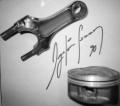Final Touch 02
by , 21-05-2014 at 01:03 PM (5992 Views)
Started the flushing service on the classic ABS and as soon as I opened the
bleeder plug, I knew itís going to take long time.
Nothing came out from the accumulator......
Not a single drip......
So the accumulator was completely empty.
Manually activated the ABS pump and immediately, I found the cause of the issue.
A certain solenoid was stuck open and leaking the fluid back to the
reservoir continuously so even the pump was trying to pressurise the system,
it couldnít build up the pressure.
Applied 12V on each solenoids and found three out of four having problem.
After spending some time, eventually, managed to release the stuck open one
and another leaky one but the last one marked 'X' didnít even make a 'click'
sound when applied 12V.
This means it's electronically dead but fortunately, itís not causing massive
leakage.
Iím going to leave this solenoid for now as it canít be fixed without replacing it
or carrying out the overhaul.
At least, I can build up the pressure now so flushed the remaining solenoids
and accumulator several times before building up the pressure with
the fresh fluid.
Due to unknown state of the one dead solenoid, it may trigger the ABS pump
from time to time when the owner starts moving the car for the first time on
the day.
Please note that dead solenoid means no ABS feature on that corner so
please pay extra attention while driving.
If doing DIY repair, it is cost effective to disassemble and replace the
dead solenoid with used one together with new o-rings on all four solenoids but
if asking someone to do it for you, itís more cost effective in longer term to
upgrade the complete system to the latest ABS if you use your NSX regularly.
If it is occasional usage, then itís only the owner who can make the decision
between the cost involved (not cheap) and the risk of driving with failed ABS.
Personally, if mainly driving on the street, I wonít recommend driving without
the ABS because if you hit something, it will cost more than the latest ABS upgrade.
If the ABS is working, there is a chance that you may be able to stop the car before
hitting the object.
At the base of ABS reservoir, there was slimy/milky thick film.
Looked like it was never flushed in the past.
Cleaned it as much as possible.
Had to replace the bolts at the L shaped bracket for the parking brake cable.
The cable was stuck in the bracket and without removing it, I wonít be able to
take the engine out so no other option.
There was no way I could re-use these heavily corroded ones.
R side parking brake cover was missing so new one and fixing bolts ordered.
Without this, it will cause lots of corrosion.
As reported earlier, there was no way I can comfortably re-use the banjo bolt
at the rear caliper so replaced it with a new one together with the new bleeder plug
at all four corners.











 Email Blog Entry
Email Blog Entry

